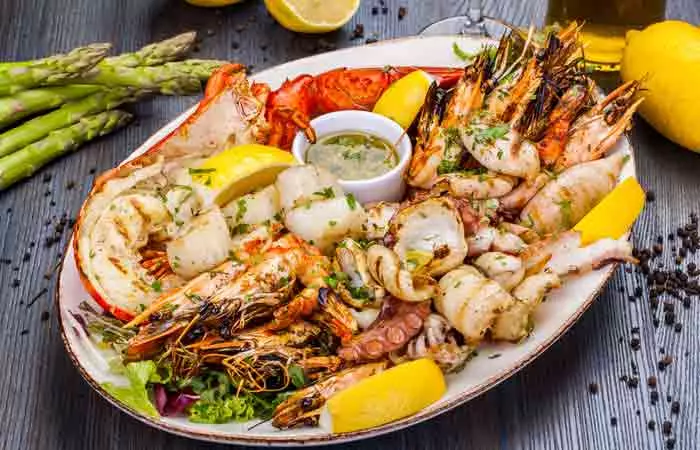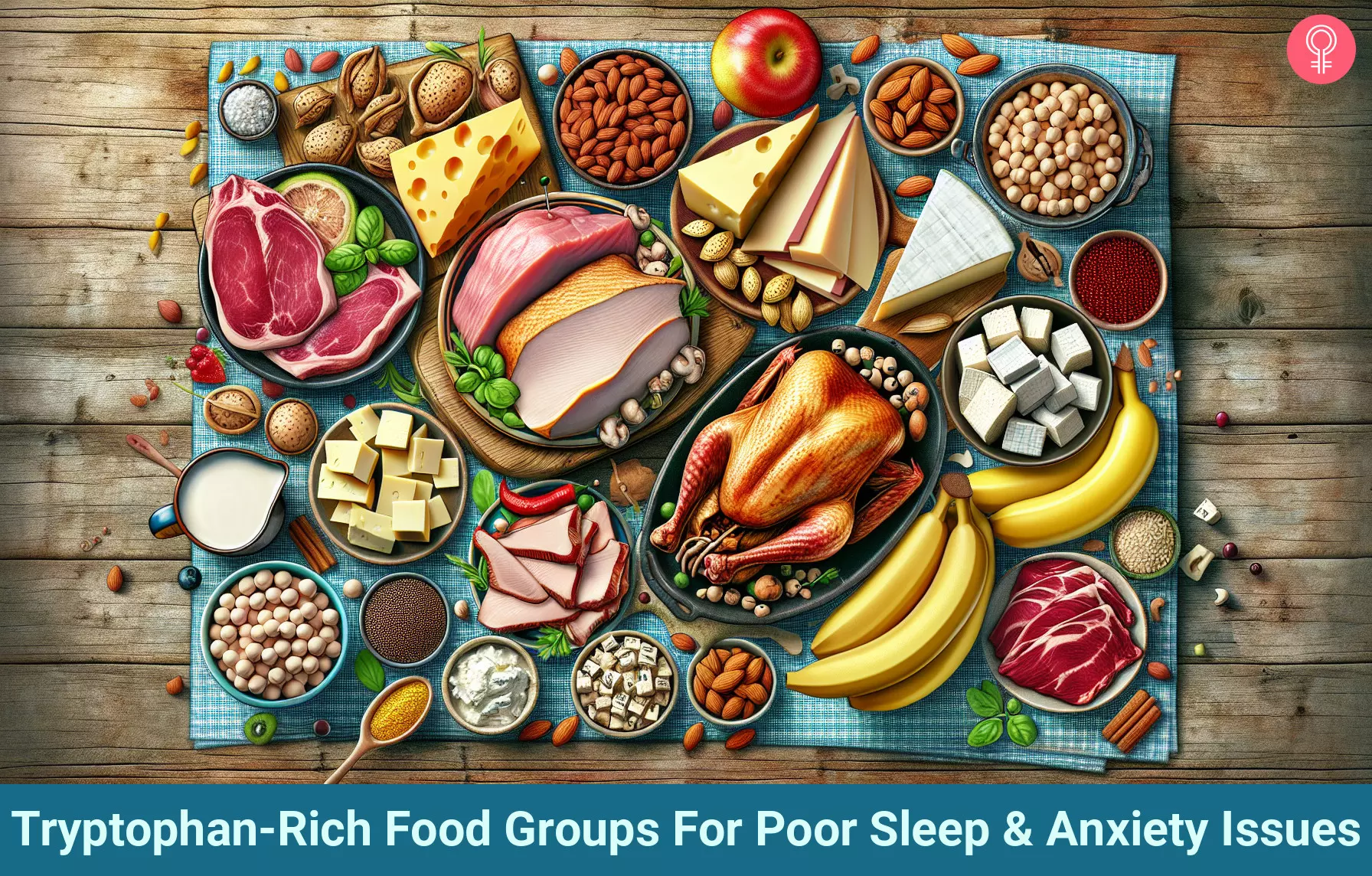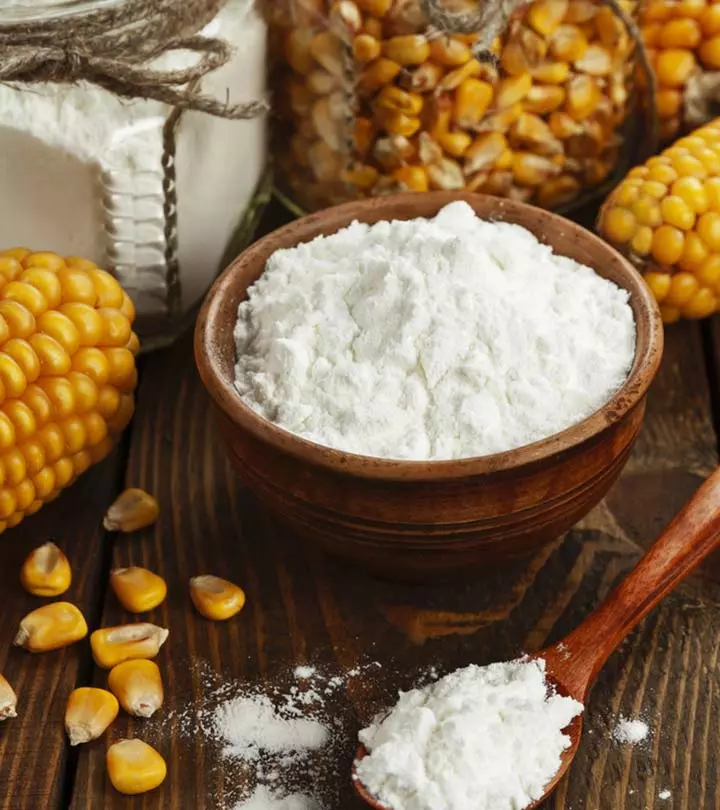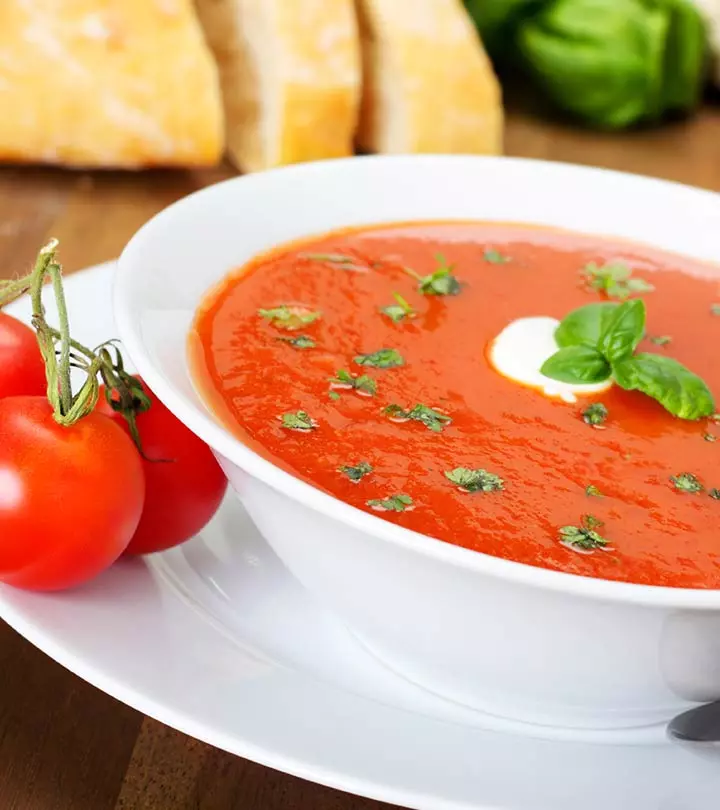Tryptophan Rich Foods: 6 Top Sources For Mood And Sleep
Foods to include in your diet to help your body reap all benefits of this amino acid.

Image: Shutterstock
Tryptophan is an essential amino acid that is used in protein synthesis. Your body cannot synthesize this biomolecule and needs to be supplemented through diet. What foods are rich in tryptophan? It is present in most protein-based foods. This amino acid is used to perform many bodily functions. It controls your mood, sleep, and hunger cycles. It is the building block of many neurotransmitters and hormones. Hence, it is important to consume this amino acid in recommended quantities.
 Trivia
TriviaThis article explores the list of top foods rich in tryptophan, their potential health benefits, and the possible side effects due to their excess intake. Keep reading to know more.
In This Article
What Is Tryptophan? Why Is It So Important?
Tryptophan is an essential amino acid. It is the precursor of a neurochemical called serotonin (1). Serotonin takes care of the regulation of your mood, anxiety, and depression.
Serotonin is made from tryptophan in two steps. The concentration of tryptophan in your brain controls the rate of serotonin synthesis. This means, lower the levels of tryptophan in your brain, lesser the rate of serotonin synthesis. Low serotonin in the brain may lead to depression, anxiety, and, in some cases, insomnia.
Tryptophan also gets converted into another important active ingredient – vitamin B3 (niacin or niacinamide). This vitamin, along with other principles, takes care of growth and development in children and adults (2).
Since it is involved in such critical processes, your body needs a constant supply of tryptophan. Can it be done?
Well, no. Your body cannot produce enough tryptophan to meet all its needs. You need to provide this amino acid externally through a diet. This is why it is called an essential amino acid (2).
Simply put, if you include foods with tryptophan in your diet, there will be enough of it in your body. Sufficient tryptophan in your brain pool ensures optimal serotonin synthesis. This means you can have a good night’s sleep!
Now comes the big question – which foods are rich in tryptophan?
Scroll to the next section for the answer!
Check out the lists below to know how much of tryptophan your favorite foods contain.
1. Fruits

| Fruit | Tryptophan Content (g/cup) |
|---|---|
| Apricots (dehydrated, uncooked) | 0.104 |
| Plantains (yellow, baked) | 0.029 |
| Kiwifruit (green, raw) | 0.027 |
| Mangoes (raw) | 0.021 |
| Oranges (raw, unpeeled) | 0.020 |
| Cherries (sweet, with pits, raw) | 0.012 |
| Papaya (raw) | 0.012 |
| Figs (raw) | 0.004 |
| Pears (raw) | 0.003 |
| Apples (raw, peeled) | 0.001 |
Source: USDA, USDA Food Composition Databases
2. Vegetables

| Vegetable | Tryptophan Content (g/cup) |
|---|---|
| Soybeans (green, raw) | 0.402 |
| Cowpeas (blackeyes, boiled) | 0.167 |
| Lima beans (boiled) | 0.151 |
| Potatoes (scalloped with butter) | 0.103 |
| Garlic (raw) | 0.090 |
| Kidney beans (sprouted, raw) | 0.081 |
| Broccoli (boiled, no salt) | 0.059 |
| Asparagus (boiled, no salt) | 0.052 |
| Brussels sprouts (raw) | 0.033 |
| Mung beans (sprouted, boiled) | 0.035 |
| Cauliflower (green, raw) | 0.025 |
| Onions (raw, chopped) | 0.022 |
| Carrots (raw) | 0.015 |
| Okra (raw, frozen) | 0.013 |
| Spinach (raw) | 0.012 |
| Kale (raw) | 0.007 |
| Leeks (boiled, no salt) | 0.007 per leek |
Source: USDA, USDA Food Composition Databases
3. Nuts And Seeds

| Nuts/Seeds | Tryptophan Content (g/cup) |
|---|---|
| Pumpkin seed kernels (roasted, salted) | 0.0671 |
| Butternuts (dried) | 0.439 |
| Sunflower seed kernels (oil roasted) | 0.413 |
| Almonds (dry roasted) | 0.288 |
| Hazelnuts (chopped) | 0.222 |
| Lotus seeds (dried) | 0.071 |
| Safflower seed meal | 0.114 |
| Chestnuts (boiled) | 0.010 |
Source: USDA, USDA Food Composition Databases
4. Seafood

| Product | Tryptophan Content (g/measure) |
|---|---|
| Yellowtail fish (cooked) | 0.485/0.5 fillet |
| Bluefish (raw) | 0.336/fillet |
| Spiny lobster (cooked) | 0.313/3 oz. |
| Queen Crab (cooked) | 0.281/3 oz. |
| Salmon (wild, coho, cooked) | 0.260/3 oz. |
| Tuna (white, canned in oil) | 0.252/3 oz. |
| Mahimahi (cooked) | 0.226/ 3 oz. |
| Herring (pickled) | 0.223/cup |
| Atlantic cod (canned) | 0.217/3 oz. |
| Blue mussels (raw) | 0.200/cup |
| Mackerel (raw) | 0.184/3 0z. |
| Wolffish (Atlantic, raw) | 0.167/3 oz. |
| Octopus (raw) | 0.142/3 oz. |
| Oyster (wild, eastern, cooked) | 0.117/3 oz. |
Source: USDA, USDA Food Composition Databases
5. Dairy Products
| Dairy product | Tryptophan Content (g/cup) |
|---|---|
| Mozzarella cheese | 0.727 |
| Cheddar cheese | 0.722 |
| Swiss cheese | 0.529 |
| Parmesan cheese (grated) | 0.383 |
| American cheese spread | 0.335 |
| Feta cheese (crumbled) | 0.300 |
| Whey (dried, sweet) | 0.297 |
| Mexican cheese (Queso chihuahua) | 0.261 |
| Cottage cheese (creamed) | 0.166 |
| Ricotta cheese (part skim milk) | 0.157/½ cup |
| Milk (3.7% milk fat) | 0.112 |
| Camembert cheese | 0.087/oz. |
| Egg (whole, raw, fresh) | 0.083/piece |
| Cream (fluid, heavy whipping) | 0.079 |
| Yogurt (whole milk, plain) | 0.034/container |
| Cream cheese | 0.010/tablespoon |
| Sour cream (cultured) | 0.005/tablespoon |
| Butter (salted) | 0.001/pat(1″sq, 1/3″ high) |

Source: USDA, USDA Food Composition Databases
6. Cereal Grains And Pasta
| Product | Tryptophan Content (g/cup) |
|---|---|
| Barley meal | 0.259 |
| Pasta (plain) | 0.183/4 oz. |
| All-purpose flour | 0.159 |
| Rice (white, long-grain, raw) | 0.154 |
| Rice flour (brown) | 0.145 |
| Sorghum flour (whole grain) | 0.128 |
| Corn grain (white) | 0.111 |
| Teff (cooked) | 0.103 |
| Somen noodles (Japanese, dry) | 0.083/2 oz. |
| Corn flour (yellow, enriched) | 0.071 |
| Cooked rice with salt (long grain, white) | 0.049 |
| Rice noodles (cooked) | 0.039 |
Source: USDA, USDA Food Composition Databases
The charts prove that there is a lot of tryptophan around us. We only have to choose the right ingredients and make our meals tasty. Also, most of these ingredients taste yum!
 Fun Fact
Fun FactWhile you are prepping to whip up some tryptophan-boosting dishes, let me quickly brief you about how tryptophan benefits you.
Key Takeaways
- Tryptophan is an essential amino acid that needs to be supplemented through proper diet and nutrition.
- It plays a crucial role in regulating mood, sleep, and diet patterns.
- Consuming an adequate amount of protein-rich diet can ensure good levels of tryptophan in your body.
What Are The Benefits Of Boosting Tryptophan Through Diet?
1. Can Reduce Anxiety, Depression, And Aggression

The synthesis of critical neurochemicalsi Small organic molecules, critical for nervous system functions, that transmit signals between the nerve cells and the organs. is dependent on tryptophan. This essential amino acid gets converted to serotonin. Several studies found that a deficiency in serotonin was responsible for anxiety, depression, and sleeplessness.
These studies revealed that people who followed diets rich in tryptophan (>10 mg/kg of bodyweight) had lesser episodes of depression and anxiety. Irritability was lower in controls and subjects that had a history of depression and anxiety (1).
It is also noteworthy that optimal supplementation of tryptophan (along with other therapeutic agents) can reduce aggression in subjects with depression, ADHDi A common neurodevelopmental disorder with symptoms like constant fidgeting, impulsive behavior, and excessive talking. , and other behavioral disorders (3).
A study conducted on 63,277 participants (divided into low and high dietary TLR subgroups) found that the depressive symptoms score was marginally higher in the low dietary tryptophan to other amino acids (TLR) group (57%) than that of the high dietary TLR group (43%). This study indicated that low tryptophan levels may be associated with depression.
2. Controls Mood Swings During PMS
Tryptophan can reduce the severity of premenstrual syndrome (PMS) in sexually active women. Subjects receiving about 6 g/day of tryptophan showed reduction in dysphoriai A state of discomfort a person experiences when their biological sex differs from their gender identity. , mood swings, and irritability when compared to controls on placebo (3).
Tryptophan is responsible for the synthesis of kynurenine, an intermediate of several key protective compounds in the body. Increased level of tryptophan is directly proportional to increased kynurenine synthesis. This chemical soothes your CNS and behavior in the late-luteal phasei The last menstrual cycle phase that starts when the pregnancy hormone levels decrease and ends on the day before the period. of the menstrual cycle (3).
3. Can Help Manage Sleep Disorders
Boosting tryptophan levels through diet can treat a variety of sleep disorders. A dose of about 2.5 mg of tryptophan given during bedtime improved the quality of sleep in individuals with obstructive sleep apnea.
Unlike other sleep disorder medications, tryptophan doesn’t slow down the person. It doesn’t limit cognitive performance or prevent you from waking up from sleep. Therefore, dietary sources of tryptophan can be used with medical supervision to manage sleep disorders early in life (3).
Tryptophan Trivia!
- Eating tryptophan-rich foods can help wean you off cigarettes, tobacco, and nicotine.
- Dietary tryptophan reduces anxiety and helps in better abstinence from smoking.
- Infants have a better regulated sleep-wake-hunger cycle if fed on natural breast milk (which is rich in tryptophan) or on tryptophan-enriched formula.
4. Might Possess Anti-inflammatory Properties
Low serum levels of tryptophan were linked to cardiovascular diseases, type 2 diabetes, inflammatory bowel disease (Crohn’s disease), chronic kidney disease, and other inflammatory diseases (4).
This proves that tryptophan might boost anti-inflammatory effects in your body. This amino acid is linked to blood glucose level control, kynurenine-mediated cardioprotection, neuroprotection, and memory power (4).
No wonder tryptophan is classified as an essential amino acid! Don’t you now agree when I say it really means business?
Now, let’s explore practical ways to incorporate tryptophan-rich foods into your daily diet.
How To Incorporate Tryptophan-Rich Foods Into Your Diet
- Start your day by including eggs, yogurt, and fruits like bananas and apples in your breakfast. Eggs are a versatile snack high in protein and tryptophan. You can eat them hard-boiled, scrambled, or in an omelet.
- Snack smart by choosing nuts, seeds, or a piece of cheese as a mid-morning or afternoon snack. You may sprinkle seeds onto a salad, cereal, porridge, etc. You may also try tofu, which is made of soy and is a rich tryptophan source. Soy products are a good option for vegetarians to replace protein sources like chicken and eggs.
- Add lean protein sources like chicken breast, fish, or beans to your lunch. Experiment with different types of fish and beans to add variety and adventure to your meals.
- Enjoy a turkey or pork roast or a hearty lentil soup for dinner.
- As an evening wind-down, have a bowl of warm milk or a piece of dark chocolate before bed.
Well, I can still sense some doubt in your head. I had it too when I was doing my research on tryptophan. All I could think of then is this.
Could There Be Any Side Effects Of Tryptophan Intake?
Valid question.
Tryptophan is involved in almost every activity our body performs. It is hence needed in large amounts. So, irrespective of the mode of intake, it better be safe!
It was found that tryptophan had a low toxicity profile in rats (2).
The 9th Amino Acid Assessment Workshop proposed a No Observable Adverse Effect Level (NOAEL) for diet-added tryptophan of 4.5 g/day for young adults (2).
This is why tryptophan is added to sleep-inducing pills and mood regulation medications.
However, there are hypotheses claiming high-meat diets containing high nicotinamide might cause infertility. Though meat products have low tryptophan levels, the conversion rate to niacin and kynurenine is higher (2).
Hence, it is recommended to keep your doctor informed about your dietary habits. Pregnant and lactating women should follow the diet plans framed by the gynecologist and/or nutritionist.
Tryptophan has numerous benefits, and you can easily get it from common fruits and vegetables. But what about its supplements? Is it safe to take them? Find out in the next section.
Are Tryptophan Supplements Safe?
Yes. According to a case study published in the Journal of Psychiatry and Neuroscience, 1 gram of tryptophan supplementation 45 minutes before bedtime is safe to consume. The study further states that the supplementation had only a few mild side effects, such as nausea, and there were no withdrawal symptoms on discontinuation. It further adds that in rare cases, tryptophan supplements may interact with drugs that improve serotonin function, resulting in serotonin syndrome, which includes mild to severe symptoms, such as shivering, diarrhea, fever, and seizures (5). Therefore, always consult your doctor before adding tryptophan supplements to your diet.
Infographic: Everything You Need To Know About Tryptophan
Tryptophan is one of the important amino acids required by the body. Since it is not produced by the body, it is vital we get it from the diet. It contributes to the body’s growth and development and is found in various foods like chicken and fish meat, eggs, soybeans, lentils, quinoa, spinach, broccoli, mushrooms, and seaweed.
Check out the infographic below to learn about tryptophan, its importance, how to obtain it, and what its supplements can do to your body.
Some thing wrong with infographic shortcode. please verify shortcode syntax
Tryptophan is an essential amino acid that plays a key role in protein synthesis. But your body can not produce enough tryptophan. So, you should supplement it through regular foods or specialized supplements. Consuming enough tryptophan may help reduce anxiety, depression, and aggression, control mood swings during PMS, manage sleep disorders, and prevent inflammatory diseases. However, the list is long when it comes to foods high in amino acids, which can benefit your overall health. Apricots, vegetables, nuts and seeds, seafood, and dairy products are some foods high in the amino acid tryptophan. Consume them in the required amounts to reap their maximum benefits.
Frequently Asked Questions
What is a high tryptophan breakfast?
A high tryptophan breakfast consists of oats, nuts, eggs, milk, tofu, and beans.
Do bananas have tryptophan?
Yes, bananas have tryptophan. A medium-sized banana has approximately 11 milligrams of tryptophan.
Is tryptophan toxic in humans?
No, tryptophan is not toxic to humans. However, the L-tryptophan supplements may cause serious side effects like drowsiness, vomiting, and blurred vision. Therefore, do not take these supplements without consulting a doctor.
How can tryptophan-rich foods be incorporated into a balanced diet?
You can prepare your favorite dishes by adding the tryptophan-rich foods mentioned in the article. However, ensure you use unprocessed ingredients rather than processed foods. Also, the recommended daily intake for adults is estimated to be between 3.5 and 6.0 mg/kg of body weight per day (3). Therefore, be careful to not consume more than recommended.
Illustration: Tryptophan-Rich Food Groups For Poor Sleep & Anxiety Issues

Image: Dall·E/StyleCraze Design Team
Learn about 10 tryptophan-rich foods that can help you sleep better and improve your mood. Watch the video below for essential diet tips you need to get a better night’s rest.
References
Articles on StyleCraze are backed by verified information from peer-reviewed and academic research papers, reputed organizations, research institutions, and medical associations to ensure accuracy and relevance. Read our editorial policy to learn more.
- “The Effects of Dietary Tryptophan on Affective Disorders” Archives of Psychiatric Nursing, US National Library of Medicine.
- “Analysis, Nutrition, and Health Benefits of Tryptophan” International Journal of Tryptophan Research, US National Library of Medicine.
- “L-Tryptophan: Basic Metabolic Functions, Behavioral Research…” International Journal of Tryptophan Research, US National Library of Medicine.
- “Tryptophan metabolism, its relation to inflammation and stress…” BMC Nephrology, US National Library of Medicine.
- “Is tryptophan a natural hypnotic?” Journal of Psychiatry and Neuroscience, US National Library of Medicine.
Read full bio of Heather M. Duquette-Wolf
Read full bio of Swathi Handoo
Read full bio of Ravi Teja Tadimalla
Read full bio of Aparna Mallampalli



























Community Experiences
Join the conversation and become a part of our empowering community! Share your stories, experiences, and insights to connect with other beauty, lifestyle, and health enthusiasts.